Vincent Tournier, Senior lecturer in political science at Sciences Po Grenoble and the Pacte laboratory
In February 2021, according to the annual barometer of the CEVIPOF, only 16% of French people said they had confidence in political parties, which places parties far behind all other organizations, including including those with the lowest ratings, such as social networks (17%), the media (28%) or trade unions (32%).
How can such a lack of confidence be explained? Is the French case unique, or can it be generalized to the whole of Europe? We're going to see that European comparisons, in particular the European Values Study (EVS) surveys, the latest wave of which was carried out in 2017, provide some answers by revealing both elements of convergence between European countries and dynamics specific to France.
Widespread mistrust?
As the Eurobarometer data show (graph 1), France is one of those countries where the level of trust in political parties is significantly lower than elsewhere (only seven countries have been retained for reasons of readability). What's more, confidence tends to remain stable or even increase in certain countries (such as Germany), which is not the case in France, where confidence is eroding despite phases of increase, such as in 2007 and 2012.
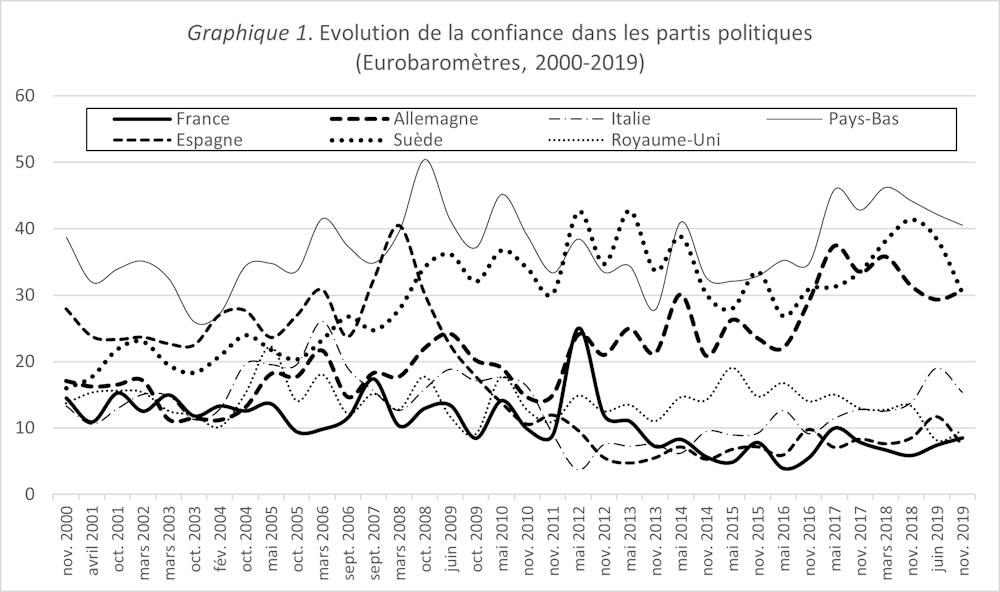
However, the Eurobarometer has the disadvantage of using a question with only two response modalities (rather confident and rather not confident). The European Values Survey (EVS), with its four modalities (high confidence, some confidence, little confidence or no confidence at all), makes it possible to isolate those individuals who express absolute distrust ("no confidence at all"), which is not the same thing as relative distrust, the latter being considered normal in a democracy where critical thinking should prevail.
In the latest EVS wave (2017), the proportion of these "absolute distrusters" stands at 45% in France. With such a figure, France is well above most Western European countries, where absolute mistrust is generally very low (and even virtually negligible in some Nordic countries).
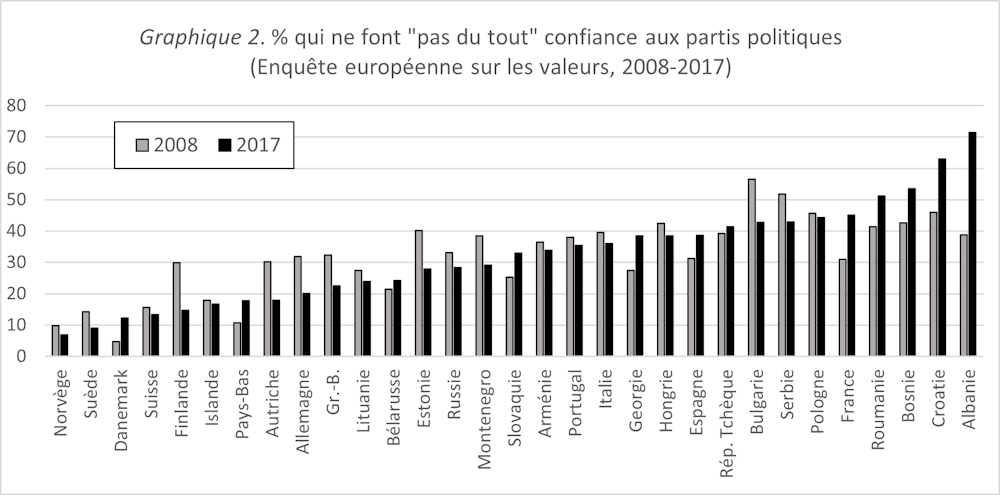
In addition, between 2008 and 2017, the proportion of people of people who answer "not at all confident" is fairly stable. There was even a drop in some countries (Finland, Austria, Germany), which shows that mistrust is not on the rise everywhere in Europe. And here again, France is the exception, with absolute mistrust rising sharply from 31% to 45%.
A membership crisis?
If the crisis of confidence is not widespread, what about what about membership? Can we say that European citizens are deserting political parties?
According to EVS, take-up rates are generally quite low rarely exceed 5%, except in a few countries (Table 1). As a result, party mobilization is low, and the trend in membership is downward. trend. In Germany and Norway, for example, a clear drop-off has occurred over time. over time, no doubt due to the difficulties experienced by the European social democratic parties . parties.
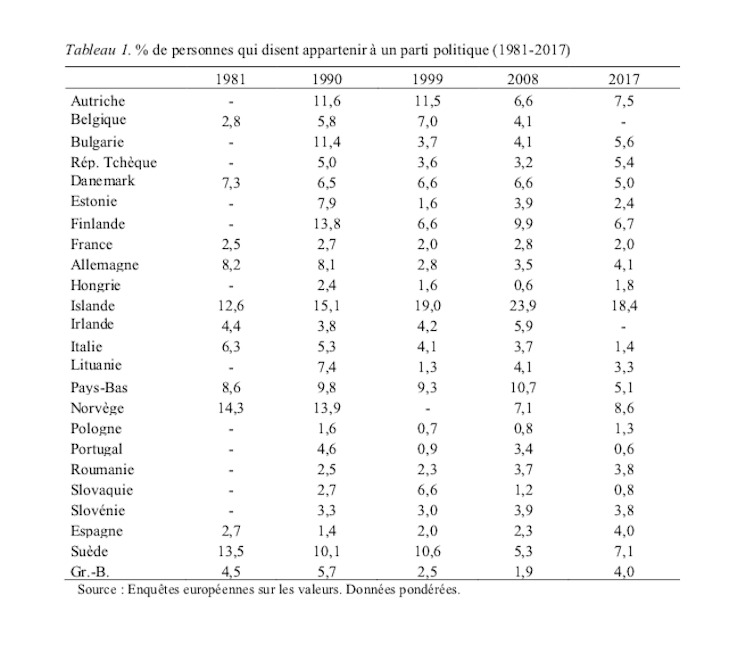
In France, the membership rate is particularly low (2% in 2017) and has changed little since 1981. France is therefore one of the countries where political party membership is lower than elsewhere. than elsewhere.
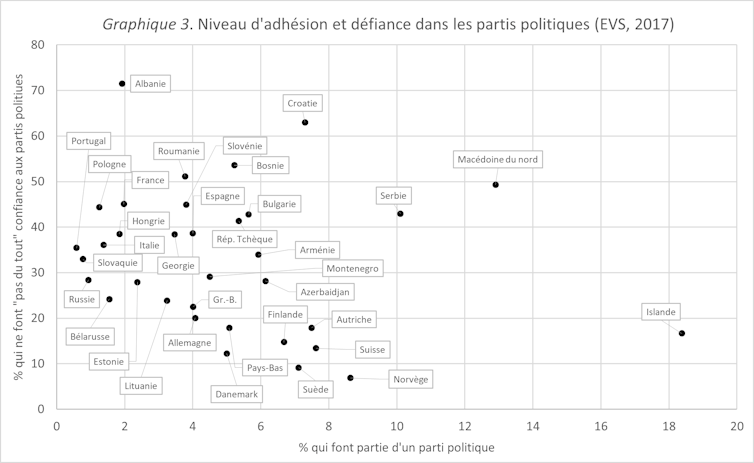
In the light of the French case, it is tempting to compare to relate membership rates to the degree of trust in political parties. could it be that membership levels are linked to a lack of trust? confidence?
In reality, this comparison is hardly relevant. Admittedly, membership rates are often higher in countries with low levels of low levels of party mistrust, but the correlation is not obvious (graph 3). For comparable levels of distrust, we can find very different very different levels of membership, and vice-versa. Membership depend very little on public perception, even if this may play a role in certain cases in some cases, as in France.
The structural weakness of political parties
Why are membership levels generally low? In his major work The Logic of Collective Action (1965), the American economist Mancur Olson explains that collective movements can only prosper and endure if they succeed in offering selective rewards to their members. By selective retribution, Olson means individual benefits granted to members. These rewards serve to offset the costs of membership (monetary, time spent, difficulty of justification, denigration, even physical risks in certain cases). Selective rewards create a powerful personal incentive to join. For example, it's in a student's interest to join the alumni association to benefit from its address book.
Olson's thesis is invaluable in understanding the structural weakness of political parties, and their relative decline. While associations can easily offer selective rewards (e.g. travel or discounts on shows), political parties cannot. By definition, they target collective goods: they propose public action programs that cannot be individualized.
When a party comes to power, it implements a program that will program that will benefit all citizens, whether or not they are party members. of the party. That's why it's in nobody's interest to join. This is what Olson stowaway phenomenon: it's in everyone's interest to stay at home and rely on the commitment of others.
Parties have a harder time today
Of course, political parties are not like associations. Their creation is the result of the major divisions that run through societies. They therefore correspond to struggles over interests or ideas, which are powerful sources of mobilization. The fact remains, however, that to maintain and develop membership, parties have no choice but to offer various rewards, both symbolic and material. In Ivry, what's left of the red suburbs? In its heyday, the French Communist Party was able to create veritable ecosystems (the "red suburbs") that enabled it to grant substantial benefits to its members.
In addition to material benefitsEducation, jobs, housing, subsidies), it provided symbolic rewards such as pride pride (legitimized by the support of intellectuals and artists) and sociability. artists) and sociability. Conversely, it also had the capacity to exclude from social life anyone who had the bad idea of criticizing him criticize him, including leaders.
Legislation weakens parties
But times have changed. The opportunities for handing out advantages have been greatly reduced by the fight against corruption and cronyism. This is the paradox of our times: legislation designed to make public life more ethical also weakens political parties. Under greater scrutiny, parties are required to demonstrate transparency and can no longer use their resources as they please, as we saw with theFillon affair or the cases of fictitious employment at the European Parliament.
Even when it comes to access to political information that used to make membership attractive, the parties have become obsolete. This function of political socialization, which was pushed furthest by the by the communists through their cadre schools, has been made obsolete by the media and social networks.
If we add to this the fact that, in our contemporary societies of prosperity and abundance, people find it more satisfying to invest in satisfaction in investing in leisure or culture, or in more valued activities associations, it's easy to see why the situation of political parties that the situation of political parties has become delicate.
French republican culture places little value on collective movements
If contemporary dynamics don't make partisan involvement any easier, there are probably five reasons why the difficulties are even greater in France. The first is the weight of a political culture shaped by history. Parties suffer from a lack of respect that stems from two factors. The first is the condemnation of collective action in the name of the general interest by the Le Chapelier law of 1791, which outlawed corporations as an attribute of the Ancien Régime.
The second is the recurring fear of organizations becoming seditious. For example, the laws on trade unions (1884) and associations (1901) were primarily aimed at controlling revolutionary circles and religious congregations, a control that was supplemented in January 1936 by the law on the dissolution of militias and combat groups, regularly activated by governments to dissolve movements deemed dangerous. As a result, Republican culture is characterized by a low value placed on collective movements, making membership more costly for individuals.
The second reason, partly related to the previous one, is the weakness of the associative movement. According to EVS, we find that the French are less involved than their European neighbors. 25% are members of an association or trade union (excluding sports associations), compared with 43% in Great Britain, 60% in Germany Germany, 70% Switzerland, 85% Denmark and 88% Iceland. Iceland.
And yet, according to the EVS, it's in countries with the highest levels of associative commitment that parties often have the most members (graph not shown). This correlation is understandable: membership of an association strengthens sociability networks and provides a stepping stone for activist careers. Some European parties have even established close links with trade unions, which is not the case in France, where trade unions, historically driven by political objectives, have refused organic links with political parties.
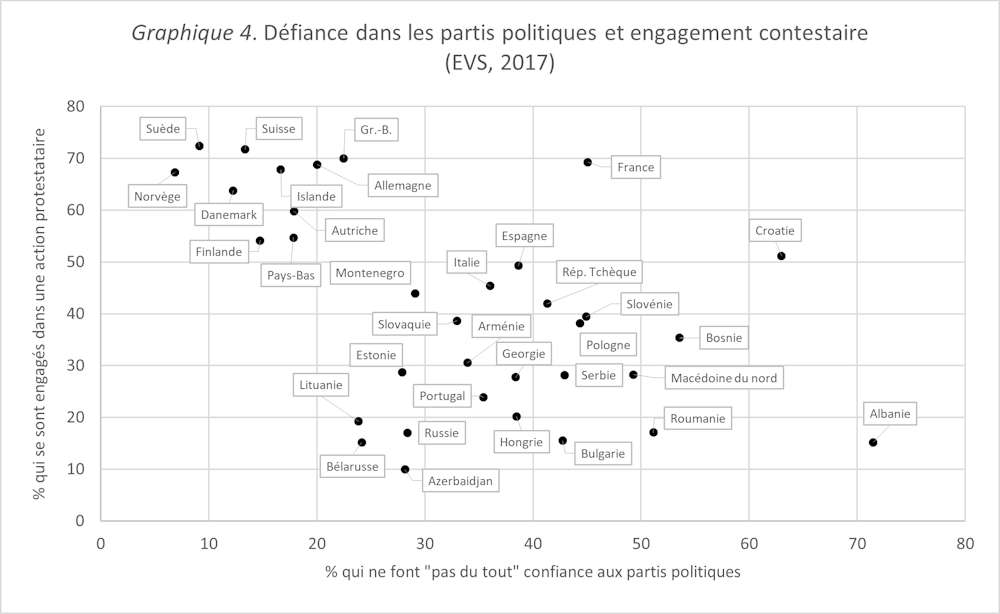
A civic model between acceptance and contestation
The third reason concerns the role of the State. Built around a strong state, French society has developed a civic model based on a dual attitude of acceptance and contestation. civic model based on a dual attitude of acceptance and contestation. The citizens are willing to defer to the State, but claim the right to intervene to intervene from time to time to influence its decisions (symptomatically to a "non-political" approach, which in French culture means: outside in French culture: outside political parties).
This situation gives France a relatively original position, as shown in graph 4, where we observe both a high level of mistrust of political parties and a high level of protest involvement (measured here by participation in petitions, boycotts or legal demonstrations).
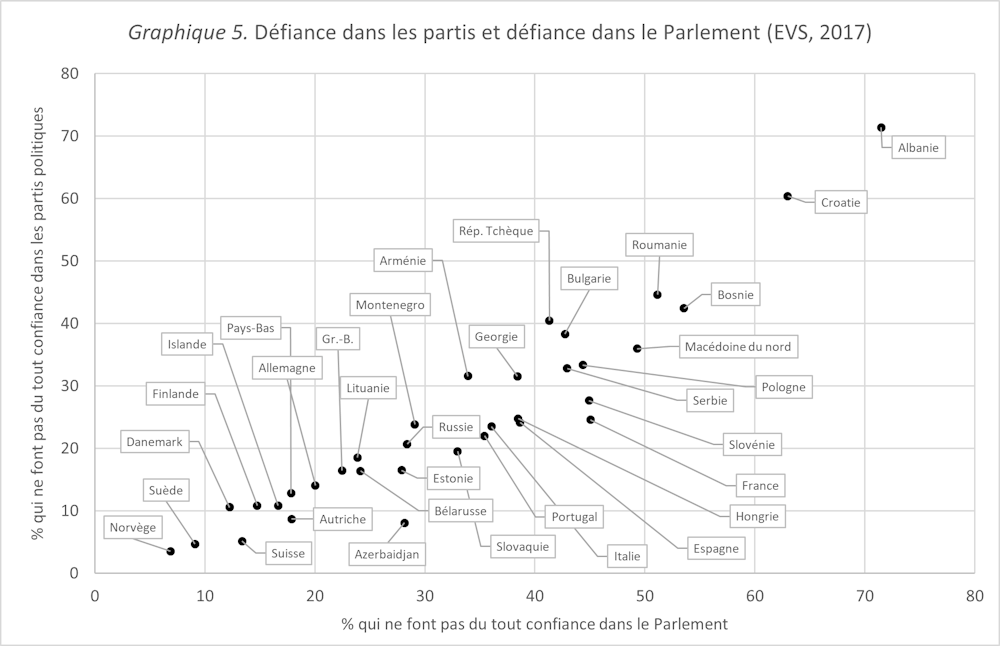
The fourth reason concerns the institutional recompositions associated with theFifth Republic. The 1958 Constitution reduced the role of Parliament in favor of the executive. And yet, the EVS data show that there is a close correlation between distrust in parties and distrust in national parliaments (graph 5). This is quite logical, since parties are historically linked to the parliamentary system (they were born at the same time). The weakening of parliament naturally reflects on parties, whose role is less obvious to the public, especially in France, where the two-round majority system limits the role of partisan apparatuses in candidate selection.
The fifth and final reason is the evolution of political life over the last few decades. The issues of immigration and insecurity have overturned political divisions, leading to the emergence of the Front National (now Rassemblement National). While this party is characterized by a rejection of the traditional parties (the "gang of four", as Jean-Marie Le Pen put it, i.e. the PCF, PS, UDF and RPR), it is itself rejected by a large proportion of the population, with the result that this mutual rejection exacerbates the crisis of confidence in the parties.
What's more, despite its electoral successes, the RN has been unable to replace the Communist Party because, unlike the latter, it suffers from a lack of relays in civil society (associations are hostile to it) and a lack of legitimacy among intellectuals and elites, even if changes seem to be taking shape. This lack of support and legitimacy increases the psychosocial cost of membership tenfold, a cost that the RN can hardly offset with selective rewards, given its marginal position in the political-administrative system.
An open future?
The preceding observations, far from exhausting the subject underline the need for further investigations into political parties. political parties. While parties have already undergone profound transformations, with the decline of mass the decline of mass parties in favor of all-purpose parties, their existence does not seem under threat, as demonstrated by the creation of La République en Marche (LREM) to accompany Emmanuel Macron's conquest of power.
The current health crisis, which follows on from the financial crisis of 2007-2008 and the migration crisis of 2015-2016, augurs an intense period of turbulence and uncertainty, the outcome of which is difficult to anticipate. But the difficulties faced by political parties in no way detract from the pivotal role they play in political life. The lack of confidence in them is neither mechanical, nor a sign of their demise. At the very most, the possible emergence of new leaders (Eric Zemmour or General de Villiers?) suggests that the party system is in for a major reconfiguration.
This analysis was originally published by The Conversation on February 23, 2020.